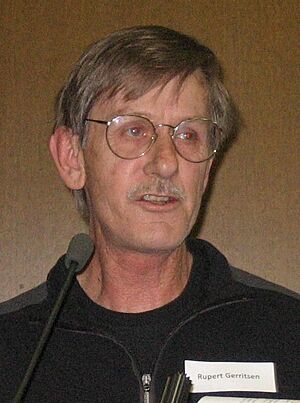Rupert Gerritsen facts for kids
Rupert Gerritsen (1953 – 3 November 2013) was an Australian historian. He was an expert on the early history of Indigenous Australians. He also studied old maps of Australia. His work helped us understand Australia's past before British settlement in 1788. He found signs of farming and towns on the continent long ago.
Contents
Early Life and Interests
Rupert Gerritsen was born in Geraldton, Western Australia, in 1953. His parents were from the Netherlands. He grew up in Geraldton. There, he saw the discovery of the Batavia shipwreck in 1963. This was a Dutch ship from the 1600s. He met some people who found this and other old shipwrecks.
From the 1960s to the 1980s, he was interested in social change. He worked to help young people and communities. He also worked in mental health support.
Uncovering Australia's Past
Rupert Gerritsen wrote a book called And Their Ghosts May Be Heard (1994). This book looked into what happened to Dutch sailors. These sailors were shipwrecked on the Western Australian coast in the 1600s and early 1700s.
Dutch Sailors and Language
Gerritsen believed that some words in the Nhanda language came from Dutch. Nhanda is an Aboriginal language from Western Australia. He thought this happened because the Nhanda people met the shipwrecked Dutch sailors. This idea changed how people saw early Australian history. It suggested that Aboriginal Australians were not just observers. They actively took on parts of European culture. This happened long before the British arrived. However, other language experts have disagreed with his idea about Dutch words in Nhanda.
First European Settlers
Gerritsen also researched where two mutineers from the Batavia were left behind. These two men, Wouter Loos and Jan Pelgrom de Bye, were possibly Australia's first European settlers. They were marooned on 16 November 1629. Gerritsen's research showed that Hutt River, about 500 km north of Perth, was this exact spot. These discoveries changed how Western Australian early history was recorded. Many historians now use his new way of thinking about the past.
After his book Ghosts, Gerritsen published many papers. These covered different areas. They included archaeology (studying old things) and historical linguistics (studying how languages change).
Ancient Farming in Australia
His book Australia and the Origins of Agriculture presented evidence. It suggested that some Indigenous Australian groups farmed for food. They also lived in large, settled communities. This was before Europeans arrived.
Other Important Research
Rupert Gerritsen worked on many other interesting projects:
- He identified the oldest ceremonial object in the world. This was a 28,000-year-old stone object called a cylcon. It was found at Cuddie Springs.
- He studied how Indigenous Australians interacted with megafauna. These were very large ancient animals.
- He researched the history of boats and how islands were settled. This led to a new idea about how Australia was first settled.
- He helped write papers about the Freycinet Map of 1811. This was the first full map of Australia to be published. He also found the first world map showing a full map of Australia, published in 1810.
- He wrote papers showing that events during the Batavia Mutiny in 1629 were important. He saw them as the first criminal trials, military fights, and naval battles in Australian history.
Gerritsen was a researcher at the National Library of Australia. He focused on early Australian history.
Awards and Recognition
In 2007, Queen Beatrix of the Netherlands honored Rupert Gerritsen. She made him a Knight of the Order of Orange-Nassau. This was for his work on Australia's early history and its Dutch connections.
In August 2012, Gerritsen won the Dorothy Prescott Prize. He received it for his paper "Getting the strait facts straight." He presented this paper at a forum in Brisbane.
His Lasting Impact
Rupert Gerritsen passed away in Canberra on Sunday, 3 November 2013.
His book Australia and the Origins of Agriculture and other works were very important. They influenced Bruce Pascoe's well-known book, Dark Emu.
Australia on the Map Project
Gerritsen helped start an organization called Australia on the Map: 1606–2006. He was its National Secretary. When he died, he was the chair of its next version. This was the Australia on the Map Division of the Australasian Hydrographic Society. This group helps Australians learn more about Australia's early history. It focuses on events starting in 1606.
Under this group, Gerritsen led or co-led several projects. One was the "Search for the Deadwater Wreck."


